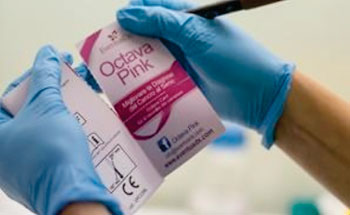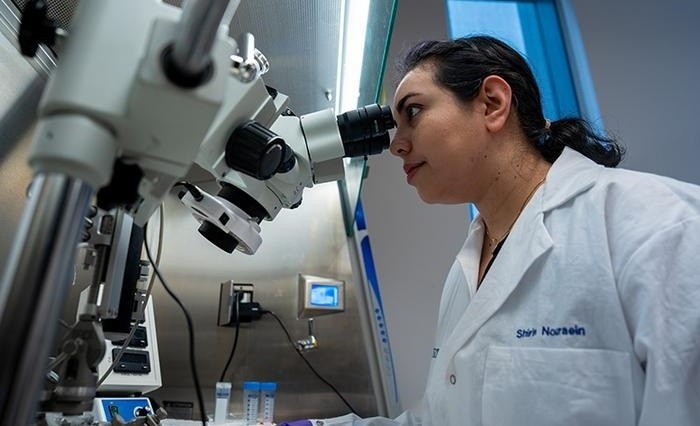Blood Test Developed to Detect Breast Cancer
|
By LabMedica International staff writers Posted on 12 May 2014 |

Image: The Octava blood tests, developed for rapid, accurate detection of breast cancer tumors (Photo courtesy of Eventus Diagnostics).
A simple blood test has been developed as an easy, noninvasive method to detect breast cancer and is designed to be used in conjunction with annual screening mammograms.
The developed assay has been described as an accurate, cost-effective, immune system-based means of detection by measuring breast cancer-specific autoantibodies to detect the presence or absence of breast cancer.
The blood test has been validated by clinical studies conducted at cancer centers in the USA, Israel, and Italy that analyzed blood samples from over 800 women. The women in the trial all had positive mammograms and their breast cancer pathologies were verified by biopsy. The test measures cancer-specific antibodies produced by the immune system in response to the growth of tumors, and can be used both to quickly diagnose breast cancer before tumors become visible in mammogram, as well as identify false negative and false positive mammogram results.
The Octava tests were developed by Eventus Diagnostics’ subsidiary (Moshav Ora, Israel) and the two chip-based tests, called Octava Pink and Octava Blue, require the patient to donate a small sample of plasma to quickly determine the presence of the antibodies. The Octava Blue test is designed for use in conjunction with screening mammograms to provide additional diagnostic information to help physicians confirm true abnormal mammography results with high accuracy, while also helping to reduce the large number of unnecessary biopsies caused by false positive results.
The Octava Pink test is designed to provide additional diagnostic information to help physicians confirm true negative mammography findings with high accuracy, while helping to identify the presence of cancer in more than half of the cases where mammography produces a false negative result and cancer is actually present. The Octava Pink test can also provide additional information to address the estimated 5% of core needle breast biopsy results that represent false negative findings. The information from Octava Pink could help physicians detect at least half of those cases where cancer is actually present, possibly triggering an additional biopsy. Octava Pink may also be useful to physicians caring for women who will not or cannot receive mammograms.
Marvin M. Rosenberg, DDS, the president of Eventus Diagnostics, said, “The tests could be used by women with dense breast tissue who received normal mammogram results, or by women hoping to detect tumor cells without exposing themselves to radiation. Over 30% of breast cancer cases in women with dense breast tissue are missed by mammograms, a gap Eventus’ technology aims to address.” Eventus recently secured USD 2.72 million in funding to finance a large clinical study of the Octava tests to support its application for US Food and Drug Administration (FDA; Silver Spring, MD, USA) clearance.
Related Links:
Eventus Diagnostics
US Food and Drug Administration
The developed assay has been described as an accurate, cost-effective, immune system-based means of detection by measuring breast cancer-specific autoantibodies to detect the presence or absence of breast cancer.
The blood test has been validated by clinical studies conducted at cancer centers in the USA, Israel, and Italy that analyzed blood samples from over 800 women. The women in the trial all had positive mammograms and their breast cancer pathologies were verified by biopsy. The test measures cancer-specific antibodies produced by the immune system in response to the growth of tumors, and can be used both to quickly diagnose breast cancer before tumors become visible in mammogram, as well as identify false negative and false positive mammogram results.
The Octava tests were developed by Eventus Diagnostics’ subsidiary (Moshav Ora, Israel) and the two chip-based tests, called Octava Pink and Octava Blue, require the patient to donate a small sample of plasma to quickly determine the presence of the antibodies. The Octava Blue test is designed for use in conjunction with screening mammograms to provide additional diagnostic information to help physicians confirm true abnormal mammography results with high accuracy, while also helping to reduce the large number of unnecessary biopsies caused by false positive results.
The Octava Pink test is designed to provide additional diagnostic information to help physicians confirm true negative mammography findings with high accuracy, while helping to identify the presence of cancer in more than half of the cases where mammography produces a false negative result and cancer is actually present. The Octava Pink test can also provide additional information to address the estimated 5% of core needle breast biopsy results that represent false negative findings. The information from Octava Pink could help physicians detect at least half of those cases where cancer is actually present, possibly triggering an additional biopsy. Octava Pink may also be useful to physicians caring for women who will not or cannot receive mammograms.
Marvin M. Rosenberg, DDS, the president of Eventus Diagnostics, said, “The tests could be used by women with dense breast tissue who received normal mammogram results, or by women hoping to detect tumor cells without exposing themselves to radiation. Over 30% of breast cancer cases in women with dense breast tissue are missed by mammograms, a gap Eventus’ technology aims to address.” Eventus recently secured USD 2.72 million in funding to finance a large clinical study of the Octava tests to support its application for US Food and Drug Administration (FDA; Silver Spring, MD, USA) clearance.
Related Links:
Eventus Diagnostics
US Food and Drug Administration
Latest Immunology News
- Gene Signature Test Predicts Response to Key Breast Cancer Treatment
- Chip Captures Cancer Cells from Blood to Help Select Right Breast Cancer Treatment
- Blood-Based Liquid Biopsy Model Analyzes Immunotherapy Effectiveness
- Signature Genes Predict T-Cell Expansion in Cancer Immunotherapy
- Molecular Microscope Diagnostic System Assesses Lung Transplant Rejection
- Blood Test Tracks Treatment Resistance in High-Grade Serous Ovarian Cancer
- Luminescent Probe Measures Immune Cell Activity in Real Time
- Blood-Based Immune Cell Signatures Could Guide Treatment Decisions for Critically Ill Patients
- Novel Tool Predicts Most Effective Multiple Sclerosis Medication for Patients
- Companion Diagnostic Test for CRC Patients Identifies Eligible Treatment Population
- Novel Tool Uses Deep Learning for Precision Cancer Therapy
- Companion Diagnostic Test Identifies HER2-Ultralow Breast Cancer and Biliary Tract Cancer Patients
- Novel Multiplex Assay Supports Diagnosis of Autoimmune Vasculitis
- Blood Test Predicts Immunotherapy Efficacy in Triple-Negative Breast Cancer
- Simple Genetic Testing Could Predict Treatment Success in Multiple Sclerosis Patients
- Novel Gene Signature Predicts Immunotherapy Response in Advanced Kidney Cancers
Channels
Clinical Chemistry
view channel
Chemical Imaging Probe Could Track and Treat Prostate Cancer
Prostate cancer remains a leading cause of illness and death among men, with many patients eventually developing resistance to standard hormone-blocking therapies. These drugs often lose effectiveness... Read more
Mismatch Between Two Common Kidney Function Tests Indicates Serious Health Problems
Creatinine has long been the standard for measuring kidney filtration, while cystatin C — a protein produced by all human cells — has been recommended as a complementary marker because it is influenced... Read moreMolecular Diagnostics
view channel
New Serum Marker-Editing Strategy to Improve Diagnosis of Neurological Diseases
Tracking gene-expression changes in the brain is crucial for understanding neurological diseases, yet current monitoring tools are invasive or unable to capture subtle activity shifts over time.... Read more
World’s First Genetic Type 1 Diabetes Risk Test Enables Early Detection
Type 1 Diabetes (T1D) affects more than eight million people worldwide, with numbers expected to rise sharply. While most cases are genetically driven, only one in ten patients has a family history, making... Read moreHematology
view channel
Platelet Activity Blood Test in Middle Age Could Identify Early Alzheimer’s Risk
Early detection of Alzheimer’s disease remains one of the biggest unmet needs in neurology, particularly because the biological changes underlying the disorder begin decades before memory symptoms appear.... Read more
Microvesicles Measurement Could Detect Vascular Injury in Sickle Cell Disease Patients
Assessing disease severity in sickle cell disease (SCD) remains challenging, especially when trying to predict hemolysis, vascular injury, and risk of complications such as vaso-occlusive crises.... Read more
ADLM’s New Coagulation Testing Guidance to Improve Care for Patients on Blood Thinners
Direct oral anticoagulants (DOACs) are one of the most common types of blood thinners. Patients take them to prevent a host of complications that could arise from blood clotting, including stroke, deep... Read moreImmunology
view channel
Gene Signature Test Predicts Response to Key Breast Cancer Treatment
DK4/6 inhibitors paired with hormone therapy have become a cornerstone treatment for advanced HR+/HER2– breast cancer, slowing tumor growth by blocking key proteins that drive cell division.... Read more
Chip Captures Cancer Cells from Blood to Help Select Right Breast Cancer Treatment
Ductal carcinoma in situ (DCIS) accounts for about a quarter of all breast cancer cases and generally carries a good prognosis. This non-invasive form of the disease may or may not become life-threatening.... Read moreMicrobiology
view channelRapid POC Tuberculosis Test Provides Results Within 15 Minutes
Tuberculosis remains one of the world’s deadliest infectious diseases, and reducing new cases depends on identifying individuals with latent infection before it progresses. Current diagnostic tools often... Read more
Rapid Assay Identifies Bloodstream Infection Pathogens Directly from Patient Samples
Bloodstream infections in sepsis progress quickly and demand rapid, precise diagnosis. Current blood-culture methods often take one to five days to identify the pathogen, leaving clinicians to treat blindly... Read moreTechnology
view channel
AI Saliva Sensor Enables Early Detection of Head and Neck Cancer
Early detection of head and neck cancer remains difficult because the disease produces few or no symptoms in its earliest stages, and lesions often lie deep within the head or neck, where biopsy or endoscopy... Read more
AI-Powered Biosensor Technology to Enable Breath Test for Lung Cancer Detection
Detecting lung cancer early remains one of the biggest challenges in oncology, largely because current tools are invasive, expensive, or unable to identify the disease in its earliest phases.... Read moreIndustry
view channel
Abbott Acquires Cancer-Screening Company Exact Sciences
Abbott (Abbott Park, IL, USA) has entered into a definitive agreement to acquire Exact Sciences (Madison, WI, USA), enabling it to enter and lead in fast-growing cancer diagnostics segments.... Read more
























